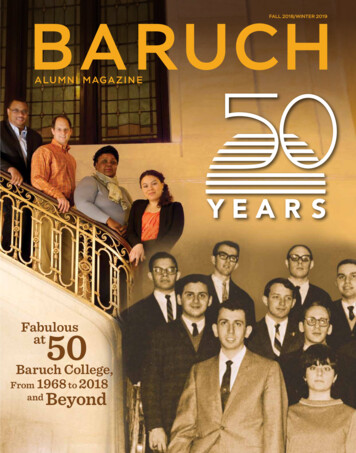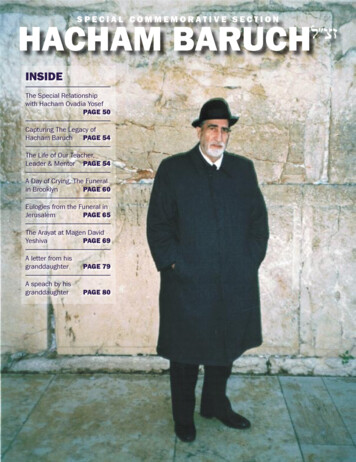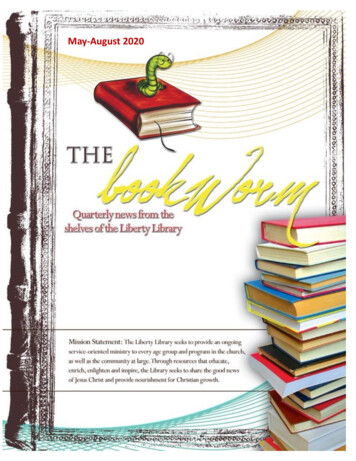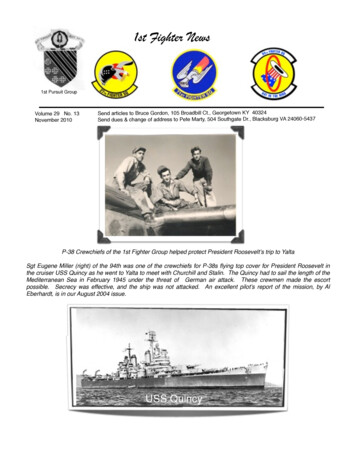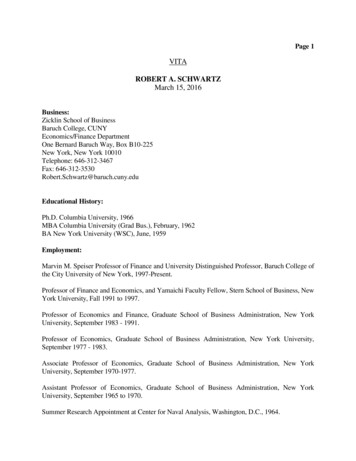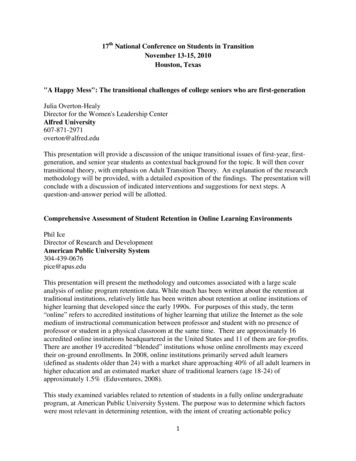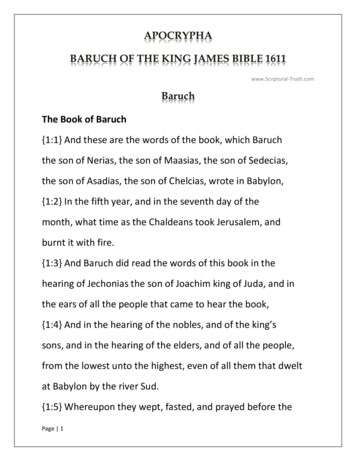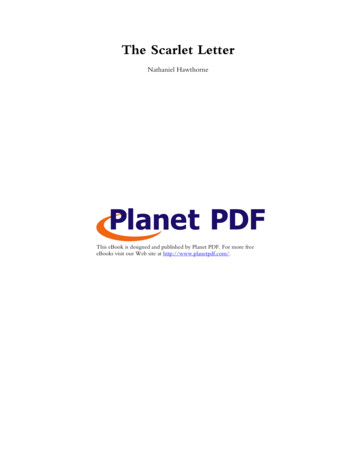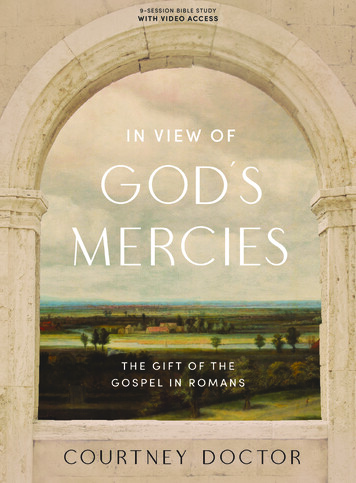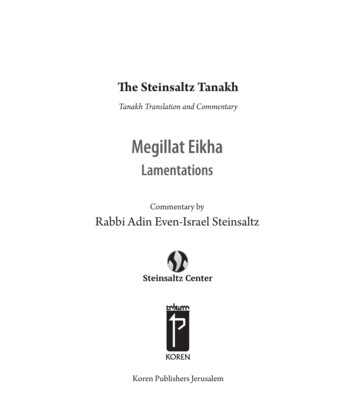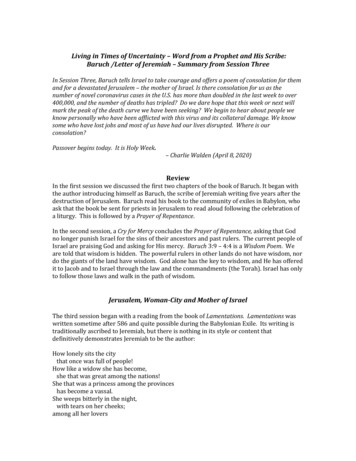
Transcription
Living in Times of Uncertainty – Word from a Prophet and His Scribe:Baruch /Letter of Jeremiah – Summary from Session ThreeIn Session Three, Baruch tells Israel to take courage and offers a poem of consolation for themand for a devastated Jerusalem – the mother of Israel. Is there consolation for us as thenumber of novel coronavirus cases in the U.S. has more than doubled in the last week to over400,000, and the number of deaths has tripled? Do we dare hope that this week or next willmark the peak of the death curve we have been seeking? We begin to hear about people weknow personally who have been afflicted with this virus and its collateral damage. We knowsome who have lost jobs and most of us have had our lives disrupted. Where is ourconsolation?Passover begins today. It is Holy Week.– Charlie Walden (April 8, 2020)ReviewIn the first session we discussed the first two chapters of the book of Baruch. It began withthe author introducing himself as Baruch, the scribe of Jeremiah writing five years after thedestruction of Jerusalem. Baruch read his book to the community of exiles in Babylon, whoask that the book be sent for priests in Jerusalem to read aloud following the celebration ofa liturgy. This is followed by a Prayer of Repentance.In the second session, a Cry for Mercy concludes the Prayer of Repentance, asking that Godno longer punish Israel for the sins of their ancestors and past rulers. The current people ofIsrael are praising God and asking for His mercy. Baruch 3:9 – 4:4 is a Wisdom Poem. Weare told that wisdom is hidden. The powerful rulers in other lands do not have wisdom, nordo the giants of the land have wisdom. God alone has the key to wisdom, and He has offeredit to Jacob and to Israel through the law and the commandments (the Torah). Israel has onlyto follow those laws and walk in the path of wisdom.Jerusalem, Woman-City and Mother of IsraelThe third session began with a reading from the book of Lamentations. Lamentations waswritten sometime after 586 and quite possible during the Babylonian Exile. Its writing istraditionally ascribed to Jeremiah, but there is nothing in its style or content thatdefinitively demonstrates Jeremiah to be the author:How lonely sits the citythat once was full of people!How like a widow she has become,she that was great among the nations!She that was a princess among the provinceshas become a vassal.She weeps bitterly in the night,with tears on her cheeks;among all her lovers
she has no one to comfort her;all her friends have dealt treacherously with her,they have become her enemies.Judah has gone into exile with sufferingand hard servitude;she lives now among the nations,and finds no resting place;her pursuers have all overtaken herin the midst of her distress.The roads to Zion mourn,for no one comes to the festivals;all her gates are desolate,her priests groan;her young girls grieve,and her lot is bitter.Her foes have become the masters,her enemies prosper,because the Lord has made her sufferfor the multitude of her transgressions;her children have gone away,captives before the foe.From daughter Zion has departedall her majesty.Her princes have become like stagsthat find no pasture;they fled without strengthbefore the pursuer.Jerusalem remembers,in the days of her affliction and wandering,all the precious thingsthat were hers in days of old.When her people fell into the hand of the foe,and there was no one to help her,the foe looked on mockingover her downfall.– Lamentations 1:1 – 7This poem describes Jerusalem after its destruction by the Babylonians and the death andexile of many of its people. Notice that like Wisdom, the city of Jerusalem is referred to as afemale. Once a princess, and now a lonely widow; a daughter, a scorned lover, she tragicallylost her friends and was overcome by her foes; she is now a vassal; but mostly she is amother whose children have been taken from her. Zion is the easternmost of two hills uponwhich the city of Jerusalem was built. In the poetry of Lamentations, or Baruch, and much ofthe rest of the Old Testament, Mount Zion (or just Zion) often refers to the city of Jerusalem,itself. Daughter of Zion also refers to Jerusalem.Jerusalem is not mentioned in the five books of Moses (the Torah) nor many other books ofthe Old Testament. But the city became very important during the Deuteronomic period.Jerusalem was prominent for most of the Twelve Minor Prophets as well as Isaiah, Jeremiahand Ezekiel. It has a major role in the stories of Second Samuel, I & II Kings, and II & II
Chronicles. When David was proclaimed king of Judah, he made Hebron, located near thecenter of the tribal territory, his capital. But following the death of Saul’s son, Ishbaal, Davidbecame king of all of Israel and moved his capital to Jerusalem near the northern border ofJudah, therefore more central to the new Kingdom of Israel. Jerusalem had not previouslybeen an Israelite city, but was occupied by the Jebusites, a Canaanite tribe. It is told thatDavid captured the city by sending his men through an underground aqueduct thatterminated within the city walls (II Samuel 5:6 – 10).David had a palace built for himself in Jerusalem as the capital of the combined kingdom ofIsrael. He also brought the Ark of the Covenant to Jerusalem and covered it with a tent – theTabernacle (II Samuel 6). David chose two chief priests, one from the north and one fromthe south to serve in Jerusalem.It was King Solomon however, who built the Temple, where the Ark was ultimately housed.The priests held ceremonies and sacrifices in the courtyard at the entrance to the Temple.The outer room of the Temple was called the Holy and the inner room was the Holy ofHolies. It was within this inner sanctum that the Ark was placed containing the tablets ofthe Ten Commandments. Two winged statues stood over the Ark serving as the throne ofYHWH. Only one priest was allowed inside the Holy of Holies, and at that, only one time peryear. For the Hebrew people, Jerusalem had become the center of their world. It was in theTemple of Jerusalem, within the Holy of Holies, where their God resided.It was to the priests and people of Jerusalem that Baruch was sending his prayers and hisbook.The Poem of ConsolationThe fourth and final section of Baruch is a Poem of Consolation. It begins with a moodsimilar to the earlier Prayer of Repentance, but with a more hopeful perspective. Once again,the style, content, and structure of the Poem of Consolation are unlike any of the writing inthe previous three sections of the book. It is possible that Baruch was written by three orfour different authors, then pasted together by a later editor. Like the poem fromLamentations, the central character in this poem is the city of Jerusalem. In much of thepoem, it is Jerusalem, herself who is singing a lament. Like the poem from Lamentations,Jerusalem is portrayed as daughter of Zion, a young woman dependent on her father, God.She is also the wife of a divine husband. She is an unfaithful adulteress; a widow; a motherof lost children. She has been raped and mistreated, and yet in the end there is hope.Marie-Teres Wacker points out that all of the metaphors for women used in this poem “playon the roles of women in patriarchal societies. . these metaphors use reality and distort itpoetically, but poetical distortion might lead to negative perspectives on realities. It is truethat the metaphors in question use female reality to criticize mainly male auditors/readers,but by doing so they actually reaffirm dichotomous images of gender relations.” While themetaphors in this poem may be intended to condemn abuse of women, the practical resultmay be to entrench male dominant and female subordinate stereotypes as just the way theworld is supposed to be.The introduction emphasizes that God wished to punish Israel because of its sins – not todestroy Israel (Baruch 4:5 – 8). In verse five, Israel is told to, “Take courage”. This is the
first of four times in this poem where that phrase is used (se also vs. 20, 27, and 30). Thereare echoes of Isaiah (40, 50, 52) as well as Deuteronomy, Psalms, and Genesis in this passage.In verse 8, Jerusalem is personified as the grieved mother. Also, in verse 8 there is areference to the “everlasting God”. Later in this poem (e.g. v. 10 and v. 14) we will see Godreferred to as “the Everlasting”, a contrast to “God” in the Wisdom Poem, and “Lord”, “LordGod of Israel”, etc. in the Prayer of Repentance, again indicating that this section may havebeen written by yet another different author than the previous three sections.But it is the characterization of Jerusalem as a woman that begins to take control of thispoem (Baruch 4:9 – 11). Half-way through verse nine, Jerusalem begins to speak to herneighbors about the exile of her sons and daughters brought on them by the Everlasting(God). Jerusalem considers herself a widow, left desolate because of her sinful children(Baruch 4:12 – 16). She tells her neighbors that a distant nation led away the widow’sbeloved sons and bereaved the lonely woman of her daughters. Jerusalem is affected by thecity’s destruction, but she herself is not guilty as her children were. Because of herinnocence, her attempts to intercede and ask for compassion in this lament can bevalidated.Jerusalem then speaks directly to the exiles, her children (Baruch 4:17 – 20). She takes offthe robe of peace and puts on the sackcloth of supplication. As a monotheist, Jerusalem hasonly one God to pray to – the one who has driven her anger, who is responsible for her loss,is the same one who must come to her rescue. Moving past her mourning, she tells herchildren (Israel) to “Take courage”, for God will deliver you (Baruch 4:22 – 26). There isalready joy. There is a series of contrasts in this passage: (1) sent out with sorrow – backwith joy; (2) . seen your capture – will see your salvation; (3) your enemy has overtakenyou – you will tread upon their necks.“Everlasting” is not the only new name for God in this poem. “O Holy One” (v. 22) is used as atitle for God in the Poem of Consolation (see also 4:37 and 5:5) but never in the other threesections of Baruch. “O Holy One” is also used frequently to refer to God in Isaiah, whichappears to be a major source document for this poem.The exiles are again admonished to, “Take courage” (Baruch 4:27 – 29) and return to theGod who brought the city’s destruction and their capture upon them. God’s salvation iscoming – and not necessarily, it seems, dependent on their return to the worship of God.Nor is this expected salvation (or the stomping on their necks) consistent with the prayerfor the Babylonians we read in the first section (Baruch 1:11 – 12). But Jerusalem givescomfort that this ordeal must soon end.The balance of the Poem of Consolation is a response to Jerusalem’s song. “Take courage, OJerusalem”, begins the next passage (Baruch 4:30 – 35). In contrast to the promise givenJerusalem and Israel, there is a message of doom for those cities who have been responsiblefor Jerusalem’s misery. Although unnamed, Babylonia is the primary culprit, but perhapsEdom is included as well. The reference to “demons inhabiting” Babylon in verse 35invokes Israel’s sin, now abandoned, of “sacrificing to demons and not to God”, in Baruch 4:7.Finally, Jerusalem is told to look to the east, toward Babylon, to see your children cominghome (Baruch 4:36 – 37). The view is broadened to include all the diaspora. The sackcloththat Jerusalem put on in verse 20, should now be replaced with the robe of righteousness.
God has given Jerusalem a new name: “Righteous Peace, Godly Glory” (Baruch 5:1 – 4). Thisnew name can possibly be traced to Jeremiah 33:16, “In those days Judah will be saved, andJerusalem will live in safety. And this is the name by which it will be called: “The Lord is ourrighteousness.” Ezekiel had his own new name for Jerusalem, “The circumference of the cityshall be eighteen thousand cubits. And the name of the city from that time on shall be,The Lord is There,” (Ezekiel 48:35). Righteousness was a characteristic that belonged toGod alone according to Isaiah (see for example Isaiah 32:17 and 60:17), yet God was givingthat name to Jerusalem, even though her inhabitants had rejected it in the past.Jerusalem is called to arise, to stand up, as her children will be carried back “as on a royalthrone,” (Baruch 5:5 – 9). The exiles will be brought home. God’s mercy will save Jerusalemand her children:For God will lead Israel with joy,In the light of his glory,With the mercy and righteousness thatcome from him.Healing a Distorted CommunityThe book of Baruch claims its intent is to heal a distorted community. As we have said earlyon, we know that community was not in Babylon or Jerusalem during the period of exile. Itwas written much later and undoubtedly was meant to deal with another situation in whichthe people of Israel were oppressed and felt disoriented. The author felt the people haddrifted away from God and needed inspiration to get back on track. From our twenty-firstcentury perspective, the situation was unlikely as dire as the Babylonian Exile, but weweren’t there. There was always a dominant threat to Israel’s existence. After Assyria inthe late eighth century, it was Egypt, then Babylon. The Persians dominated the area afterdefeating the Babylonians in 539 b.c.e. Alexander the Great conquered the Persian Empirein 334. After Alexander’s death in 323, his empire was divided among his generalsLysimachus, Cassander, Ptolemy and Seleucus. The Greeks ruled Israel until Pompeyconquered Jerusalem for Rome in 63 b.c.e. Roman rule lasted for several more centuries.It is likely that the Baruch was written during the period of Greek rule. The Maccabeanrevolt in 167 to 160 was led by the Maccabees against the Seleucid Empire. But there wasoppression of Jews all over the Diaspora during this period. Greek culture had tremendousinfluence on Jews outside of Israel during this period, often leading them to forget theirheritage and downplay their own God. We may never know the specific issue that theauthor(s) was concerned with, but his (their) hope clearly was that the message of theBabylonian Exile would help lead the Jewish people back to their own God, YHWH.The primary problem, according to the author was that the people of Judah had not been listeningto God. They, their rulers, their kings and their ancestors were not listening to God or hisprophets. They committed sin; they had lost their way. The solution, according to the author wasto repent and to begin again to follow the law. There were however, very few specifics. Forexample: there was no insistence on keeping the Sabbath; no mention of the fourcommandments that Jeremiah wrote about in his temple speech (stealing, murder,committing adultery, swearing falsely); nothing about regulating the social life of thecommunity (unlike Ezra he doesn’t blame foreign women for cults or idolatry); and he
doesn’t demand divorce for mixed marriages (Israelite men and foreign women). Was thebook effective for its intended audience?We will probably never know.Next SessionIn Session 4 we will discuss the Letter of Jeremiah. Most often, The Letter of Jeremiah ispublished as Chapter Six of Baruch. We will continue to consider the feminist viewpointpresented by Marie-Theres Wacker. We will also look at alternative viewpoints, differentthan those taken by the author of the Letter of Jeremiah.Before we begin that letter, however, a short introduction to the book of Jeremiah may behelpful. Jeremiah’s call came in the 13th year of Josiah’s reign (626 b.c.e.) and hiswriting continued down to the exile of Jerusalem, in the fifth month (586). It isdifficult to tell what prophecies were made when during this period, because theyare not written in the book of Jeremiah in chronological order. The book containspoetic oracles, some biographical stories about the prophet and some additionsfrom Deuteronomist compilers. The heart of his message is found in Chapters 1 – 25.Oracles against the nations (46 – 51) are also poetry but may not have been writtenby Jeremiah. The biographic stories are traditionally attributed to Baruch but mayhave been written by others. Jeremiah wrote primarily during the pre-exilic period –but the book seems to have later been shaped to address the exiles and those in thepost exilic period.Most of the book of Jeremiah reflects the period of Babylonian dominance over Judah,especially during the reigns of Jehoiakim and Zedekiah. This was a period of turmoil thatresulted from conflicting political policies in the royal court of Judah. Jehoiakim had beenplaced on the throne by the Egyptian pharaoh Necho II who deposed Jehoahaz. Jehoahazassumed the throne of Judah upon the death of Josiah in 609 b.c.e. Josiah had attempted toprevent the Egyptians from assisting the Assyrians against the Babylonians, but he was slain inbattle at Megiddo (2Kings 23:29). Jehoiakim began his reign as a vassal to Egypt, but whenNebuchadnezzar of Babylon defeated the Egyptians at the Battle of Carchemish (605 b.c.e.), hebecame a vassal of Babylon. Jehoiakim was caught between two faction: those who sought tothrow off Babylonian rule and those who sought to remain loyal vassals of Babylon. Jeremiah’sposition is consistent with the latter group. Jehoiakim’s policy of vacillation between thesefactions brought the Babylonian army to Jerusalem in 597 b.c.e. Jehoiakim died before feelingthe full wrath of the Babylonians. Though the Babylonians did not destroy the city at this time,they did take the new king, Jehoiachin, into exile with several thousand leading citizens andthey put Zedekiah on the throne of Judah. Zedekiah’s reign was marked by the same dividedpolicies of Jehoiakim and, as a result, the Babylonians laid siege against Jerusalem in 588 b.c.e;the city and its temple were destroyed in August of 587 b.c.e. (or 586). Zedekiah attempted toescape but was captured by the Babylonians. They killed his family in his presence, then he wasblinded and taken to Babylon. Jeremiah was most active as prophet during the reigns ofJehoiakim and Zedekiah. – Pauline A. Viviano (from Jeremiah Baruch: New Collegeville BibleCommentary)
Jeremiah is a fairly long book, comprising fifty-two chapters. (The Greek version of Jeremiah(from the Septuagint) is 1/8 shorter than the Hebrew version.). If you would like to have ataste of Jeremiah, without reading the entire book, try reading Jeremiah 3:1 – 18.Letter of JeremiahThe Letter of Jeremiah is supposed to be a letter from Jeremiah sent, at God’scommand, to the people who had been carried into exile, either the exile of 597 orthe exile of 587/586. It starts by stating the reason for the exile – sinfulness. It givesthe duration of the exile – up to 7 generations (140 years) which would take us tothe time when Ezra read from the Bible. (around 446). In reality it was only fortyseven years from destruction of temple until Jews were allowed back in 538.The remainder of the letter is poetry warning against idolatry. This was an issuethat Jeremiah was concerned with in Jerusalem early on. The temptation wouldhave been much greater in Babylon where there were plenty of idols to choose from.The Black Plague, Novel Coronavirus, and Baruch of the Second Temple PeriodThe Black Death was a devastating global epidemic of bubonic plague that struck Europeand Asia in the mid-1300s. The plague arrived in Europe in October 1347, when 12 shipsfrom the Black Sea docked at the Sicilian port of Messina. Thomas Cahill quoted thefourteenth century writer Giovanni Boccaccio (Decameron) extensively on the plague: “Inthe face of this pestilence no human precaution or remedy was of any avail, writes Boccaccio.Its first symptom in both men and women were swellings in groin or armpit, which soonwould grow to the size of an egg or apple, then spread throughout the body, turning black orsometimes livid. Few of the sick recovered, and almost all died after the third day .Not onlydid talking to or keeping company with the sick induce infection and he death that spreadeverywhere, but also touching the clothes of the sick or touching anything that had come incontact with them or been used by them seemed to communicate the disease . There werethose who thought that abstemious living and the avoidance of any extravagance might do thetrick. They shut themselves up in houses where there were no sick people and even refused tospeak to outsiders (social distancing – 14th century style) or listen to any news of the sick andthe dead who lay outside . Others thought otherwise: they believed that drinking to excess,enjoying themselves, singing their hearts out . was the best medicine. Reverence for law,whether divine or human . virtually disappeared, since the ministers of religion and themagistrates of secular law were all dying off, just like everyone else.“. one citizen avoided another, almost no one took care his neighbor, relatives seldom, if evervisited one another . brother deserted brother, uncle forsook nephew, sister left brother, andvery often wife abandoned husband, and worse, almost unbelievable – fathers and mothersstopped caring for their children as if they were not their own.”“The pandemic killed off about half of Europe’s population, worldwide possibly as many as ahundred million . Wherever the plague struck waves of accusation and intolerance seemedto strike in its wake. Sinners were responsible, or heretics, or foreigners, or beggars, orlepers – whoever was Other. In early 1349, the Jews of Strasbourg were slaughtered, laterthat year all the Jews of Mainz and Cologne.”
The Black Death (the Black Plague) was the end of medieval European civilization. WhenEurope recovered, and it did not do so quickly, the world had changed. The Renaissance,begun in the early 1300’s took off in the late 1300s. A hundred years after the Black Death,movable type made the printing press possible, which made books available to a largeportion of the population. Christopher Columbus sailed to America in 1492. The ProtestantReformation beginning in the early 1500’s radically altered the face of religion in Europe. Inthe sixteenth and seventeenth centuries men like Rene Descartes and John Locke changedthe way the world thought about science. The Black Death marked not only the end of theMiddle Ages. It marked the beginning of the modern world.The coronavirus of 2020 will not likely have this kind of impact. Currently there are overone and a half million known cases of COVID-19 in the world. In the United States thenumber is over 431,000 with 14,600 deaths so far. There were at least 779 new deaths inNew York today. More people have now died in New York of novel coronavirus (6,268)than died on 9/11. We are told there are still shortages of tests, masks, gloves, eyeprotection, ventilators, and potentially hospital beds throughout the country. The Presidentfinally enacted the Defense Production Act last week giving the federal government broadauthority to direct private companies to meet the needs of national emergencies, such asmanufacture of ventilators. There is hope that the level of new deaths in the U.S. will peakthis week or next week as a result of nearly nationwide stay-at-home and social distancingorders. We don’t yet know when this will end or what permanent changes we will see as aresult. We expect the shelter in place restrictions will not end soon.We don’t even know what specific problem “Baruch” of the Second Temple period wastrying to alleviate when he wrote his book. We know that long after the penning of Baruch,most of the Jews were expelled from Palestine by the Romans as a result of wars from 66 to136 c.e. We know Jews have been persecuted at various times throughout history. Theslaughtering of Jews during the Black Death mentioned above is one example. Cahill tells usthat “by 1351, more than two hundred Jewish towns and urban neighborhoods acrossEurope had been obliterated.” Jews did not return to their homeland in Palestine in largenumbers until 1948 when the modern Jewish State of Israel was established following theend of World War II. Over six million Jews were killed in concentration or death camps likeAuschwitz during the final years of that war.Sources:The New Oxford Annotated Apocrypha, New Revised Standard Version, Revised FourthEdition – Michael D. Coogan, Marc Z. Brettler, Carol A. Newsom, Editors,Oxford University Press, 2010Baruch and the Letter of Jeremiah (Wisdom Commentary – Volume 31) by MarieTheres Wacker, Carol J. Dempsey, OP, Volume Editor, Barbara E. Reid, OP,General Editor, Liturgical Press, Collegeville, MN., 2016Jeremiah, Baruch -New Collegeville Bible Commentary, by Pauline A. Viviano,Liturgical Press, Collegeville, MN., 2013Who Wrote the Bible? Second Edition, Richard Elliott Friedman, HarperCollins, 1987,1989, 1997Heretics and Heroes: How Renaissance Artists and Reformation Priests Created OurWorld, Thomas Cahill, Anchor Books, New York, 2013, 2014
Baruch /Letter of Jeremiah - Summary from Session Three In Session Three, Baruch tells Israel to take courage and offers a poem of consolation for them and for a devastated Jerusalem - the mother of Israel. Is there consolation for us as the number of novel coronavirus cases in the U.S. has more than doubled in the last week to over
